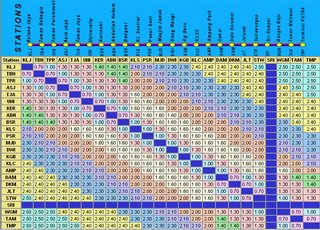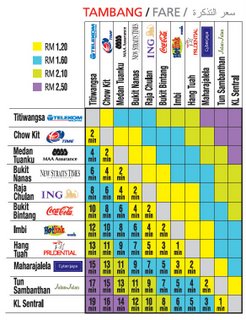Fair fares
With the fragmentation of the rail networks, I feel that commuters, especially those who need to use more than one line to complete a journey are most unfairly penalized.
Most obviously commuters are penalized when they have to walk up and down numerous flights of stairs and escalators (and cross main roads) just to reach another platform. Just think Masjid Jamek or KL Sentral Monorail. Argh.
Then there is also the pain of queuing (aiyoh, how to spell?) and buying tickets all over again. This has been partly solved with Touch 'n Go being available systemwide (with the exception of the ERL I think). But there's still plenty to be desired of.
Ok. Even if they fix all these shortcomings mentioned above, there is still one major disincentive that hasn't and will need to be rectified soon.
It is regarding the "starting fare", this fixed-fee that ALL rail operators impose on users. For example, when you hop on the Kelana Jaya Line, you have to pay at least RM0.70 or RM1.00 for the shortest journey you make, that is a one-station journey. (I'm not sure whether you'll be charged when you enter a station and leave from the same one. Any TnG volunteers? Go in and use the toilet and exit?)
Similarly, on the Ampang/Sri Petaling, that fare is RM0.70, RM1.00 and RM1.20. On the Monorail, it is RM1.20 (see how expensive KL Monorail is). For the Komuter, it is RM1.00.

Kelana Jaya line

Sri Petaling and Ampang Line

KL Monorail
And KTM Komuter
So, everytime a commuter needs to travel through more than one line, he/she has to pay this "starting fare" all over again, even though technically he/she has only made only one journey.
(You see, that's why I don't really believe these Malaysian public transport statistics half the time. After they count dunno how many thousand people on the LRTs and another how many thousand on the Komuter and then present total usage, have they accounted for this double counting? Hell, do they even account for the fact that people usually take 2 journeys, one there and one back? Or that passengers also need to hop on buses to get to the rail stations?)
I would like to suggest that all the operators come together and agree on a consolidated, system-wide fare structure that eliminates all these "starting fares". I feel that passengers should only pay for one "starting fare" for every one journey. A journey being defined as travel from one train station to another. Intermediate stops and changes shouldn't be counted.
 To illustrate this stupidity, let's consider a journey from Pasar Seni to Bandaraya. One's on the Kelana Jaya line, the other on the Ampang/Sri Petaling. A 1.6km journey by road and the LRTs.
To illustrate this stupidity, let's consider a journey from Pasar Seni to Bandaraya. One's on the Kelana Jaya line, the other on the Ampang/Sri Petaling. A 1.6km journey by road and the LRTs.
How about the transport operators introduce something like this:
 First of all is the physical. All these lines are physically disconnected (and involve walking up and down stairs and escalators). It's going to be bloody expensive and near impossible to separate passengers transfering from the Kelana Jaya line to the Sri Petaling / Ampang one. New escalators, stairs and tunnels have to be built. And looking at the Masjid Jamek geography, that is impossible, unless we want to cause more floods?
First of all is the physical. All these lines are physically disconnected (and involve walking up and down stairs and escalators). It's going to be bloody expensive and near impossible to separate passengers transfering from the Kelana Jaya line to the Sri Petaling / Ampang one. New escalators, stairs and tunnels have to be built. And looking at the Masjid Jamek geography, that is impossible, unless we want to cause more floods?
Secondly, it is a technological problem. With manual tickets, this is impossible, unless we close one more eye to let fare dodgers in. Magnetic tickets also pose another problem as I believe that all systems run different ticketing systems. Even between Sri Petaling / Ampang and Kelana Jaya. Unlimited passes aren't a problem. Probably the Touch 'n Go can be programmed to allow people to exit a platform, take another flight of escalators, and hop onto another platfrom, without charging the "starting fare" again.
Thirdly, it is a business problem. This is probably the toughest. Looking at the fare structures, you can see that operators collect most of their revenue from this "starting fare". The maximum fares on the LRTs and Monorail range from around RM2.50 to RM2.80. Compare that with their "starting fares" of RM0.70 to RM1.20. Slightly less than half of their single ticket revenue comes from this unfair fare.
The solutions...
I think trying to physically separate exiting passengers from those changing lines is going to be expensive and impossible. Blame it on the short sighted, greedy and corrupt planners and implementers of the past. But where do we go from here? I think we have to accept that not very much physical integration can be added. Maybe more covered walkways and escalators. But separating this passenger traffic, hmmm... not at most interchanges.
Technologically, I would advocate scrapping all forms of manual tickets. I have argued before why we should do away with them here and here. As for magnetic tickets, we should also do away with them because they are not cross compatible across systems. Stored value electronic cards like the Touch 'n Go meanwhile, I believe, is capable of going round this problem. How about allowing passengers that exit interchanges enter another system in the vicinity (e.g. the Masjid Jameks, Bukit Nenas - Dang Wangi, Titiwangsas, Bank Negara - Bandaraya, KL Sentral)
within a given time limit. Maybe 5 minutes for inside Sentral, 10 minutes for more physically challenging like Bandaraya - Bank Negara and Masjid Jamek, and 15 minutes for the near impossible like KL Sentral Monorail? If they re-enter the system within that specified time, using the same ticket, i.e. TnG, let all that be counted as only one journey and add only the fare increment without charging the "starting fare" again.
The business solution? I have a few:
At any rate, the overall system fare structure has to be re-examined as soon as possible.
Summarizing...



* even more IDEALLY better still allow train changes at the same platform, like Singapore's City Hall and Raffle's Place.
** with electronic stored value cards like TnG, there won't even be a need to purchase tickets (or surrendering them at the end of the journey). You will just need to validate them before, after and in-between journeys.
Most obviously commuters are penalized when they have to walk up and down numerous flights of stairs and escalators (and cross main roads) just to reach another platform. Just think Masjid Jamek or KL Sentral Monorail. Argh.
Then there is also the pain of queuing (aiyoh, how to spell?) and buying tickets all over again. This has been partly solved with Touch 'n Go being available systemwide (with the exception of the ERL I think). But there's still plenty to be desired of.
Ok. Even if they fix all these shortcomings mentioned above, there is still one major disincentive that hasn't and will need to be rectified soon.
It is regarding the "starting fare", this fixed-fee that ALL rail operators impose on users. For example, when you hop on the Kelana Jaya Line, you have to pay at least RM0.70 or RM1.00 for the shortest journey you make, that is a one-station journey. (I'm not sure whether you'll be charged when you enter a station and leave from the same one. Any TnG volunteers? Go in and use the toilet and exit?)
Similarly, on the Ampang/Sri Petaling, that fare is RM0.70, RM1.00 and RM1.20. On the Monorail, it is RM1.20 (see how expensive KL Monorail is). For the Komuter, it is RM1.00.

Kelana Jaya line

Sri Petaling and Ampang Line

KL Monorail
And KTM Komuter
So, everytime a commuter needs to travel through more than one line, he/she has to pay this "starting fare" all over again, even though technically he/she has only made only one journey.
(You see, that's why I don't really believe these Malaysian public transport statistics half the time. After they count dunno how many thousand people on the LRTs and another how many thousand on the Komuter and then present total usage, have they accounted for this double counting? Hell, do they even account for the fact that people usually take 2 journeys, one there and one back? Or that passengers also need to hop on buses to get to the rail stations?)
I would like to suggest that all the operators come together and agree on a consolidated, system-wide fare structure that eliminates all these "starting fares". I feel that passengers should only pay for one "starting fare" for every one journey. A journey being defined as travel from one train station to another. Intermediate stops and changes shouldn't be counted.
 To illustrate this stupidity, let's consider a journey from Pasar Seni to Bandaraya. One's on the Kelana Jaya line, the other on the Ampang/Sri Petaling. A 1.6km journey by road and the LRTs.
To illustrate this stupidity, let's consider a journey from Pasar Seni to Bandaraya. One's on the Kelana Jaya line, the other on the Ampang/Sri Petaling. A 1.6km journey by road and the LRTs.- Pasar Seni to Masjid Jamek - RM1.00
- Masjid Jamek to Bandaraya - RM1.20
How about the transport operators introduce something like this:
- Pasar Seni to Masjid Jamek - RM1.00 (let them keep the starting fare)
- Masjid Jamek to Bandaraya - RM0.40 (a "fair incremental fare", although I think RM0.20 should suffice)
 First of all is the physical. All these lines are physically disconnected (and involve walking up and down stairs and escalators). It's going to be bloody expensive and near impossible to separate passengers transfering from the Kelana Jaya line to the Sri Petaling / Ampang one. New escalators, stairs and tunnels have to be built. And looking at the Masjid Jamek geography, that is impossible, unless we want to cause more floods?
First of all is the physical. All these lines are physically disconnected (and involve walking up and down stairs and escalators). It's going to be bloody expensive and near impossible to separate passengers transfering from the Kelana Jaya line to the Sri Petaling / Ampang one. New escalators, stairs and tunnels have to be built. And looking at the Masjid Jamek geography, that is impossible, unless we want to cause more floods?Secondly, it is a technological problem. With manual tickets, this is impossible, unless we close one more eye to let fare dodgers in. Magnetic tickets also pose another problem as I believe that all systems run different ticketing systems. Even between Sri Petaling / Ampang and Kelana Jaya. Unlimited passes aren't a problem. Probably the Touch 'n Go can be programmed to allow people to exit a platform, take another flight of escalators, and hop onto another platfrom, without charging the "starting fare" again.
Thirdly, it is a business problem. This is probably the toughest. Looking at the fare structures, you can see that operators collect most of their revenue from this "starting fare". The maximum fares on the LRTs and Monorail range from around RM2.50 to RM2.80. Compare that with their "starting fares" of RM0.70 to RM1.20. Slightly less than half of their single ticket revenue comes from this unfair fare.
The solutions...
I think trying to physically separate exiting passengers from those changing lines is going to be expensive and impossible. Blame it on the short sighted, greedy and corrupt planners and implementers of the past. But where do we go from here? I think we have to accept that not very much physical integration can be added. Maybe more covered walkways and escalators. But separating this passenger traffic, hmmm... not at most interchanges.
Technologically, I would advocate scrapping all forms of manual tickets. I have argued before why we should do away with them here and here. As for magnetic tickets, we should also do away with them because they are not cross compatible across systems. Stored value electronic cards like the Touch 'n Go meanwhile, I believe, is capable of going round this problem. How about allowing passengers that exit interchanges enter another system in the vicinity (e.g. the Masjid Jameks, Bukit Nenas - Dang Wangi, Titiwangsas, Bank Negara - Bandaraya, KL Sentral)
within a given time limit. Maybe 5 minutes for inside Sentral, 10 minutes for more physically challenging like Bandaraya - Bank Negara and Masjid Jamek, and 15 minutes for the near impossible like KL Sentral Monorail? If they re-enter the system within that specified time, using the same ticket, i.e. TnG, let all that be counted as only one journey and add only the fare increment without charging the "starting fare" again.
The business solution? I have a few:
- Come up with a revenue sharing scheme. Have a committee consisting of the operators and the transport authorities to decide how to split the "starting fare".
- Transfer ownership of supporting infrastructure (stations, ticketing services, other infrastructure such as bus stops, overhead bridges, shops) to the main transport authority, while transport operators only manage transport operations (i.e. moving the trains around). "Starting fare" goes to transport authority to maintain these supporting infrastructure while incremental fares go to transport operators. This is like the division between Airlines and Airport Operators.
- Have other transport operators transfer management of ticketing, marketing and support services to Rapid KL. Let Rapid KL be sole seller of tickets on all systems, under the Rapid KL badge. Other operators run operations in exchange of annual fee from Rapid KL. Like here. Problem of "starting fare" non-existent. Furthermore, issue of revenue distribution with unlimited passes will be almost non-existent too.
- Abolish starting fares altogether. But operators will argue for a steeper fare curve to compensate lost revenue. That means fare increments between stations would be higher, although there would be no "starting fare" to begin with (no pun).
At any rate, the overall system fare structure has to be re-examined as soon as possible.
Summarizing...
* even more IDEALLY better still allow train changes at the same platform, like Singapore's City Hall and Raffle's Place.
** with electronic stored value cards like TnG, there won't even be a need to purchase tickets (or surrendering them at the end of the journey). You will just need to validate them before, after and in-between journeys.

3 Comments:
I agree with most of your points except for the 1st one about the physical problem with regards to escalators and walking loads just to change lines.
I don't think there is anything any engineering designer can do about that due to various geographical constraints of the station.
The so-called awesome London tube has exactly the same thing. You have to go through loads of (confusing) tunnels and escalators (some of which span dizzying heights) just to change lines.
In Paris, it is even worse. At some stations, you have to walk 5 mins through their subway labyrinth to change lines (my mum with a bad knee had serious problems there).
In my later post (http://klcommuter.blogspot.com/2006/09/report-card-masjid-jamek-lrt.html) I have discussed some alternatives, given the mistakes we have made in the 1990s. I hope Rapid KL and other local governments can fix this.
Paris and London metros are older than Malaysia. I can understand why it's a labyrinth. But KL in 1998, I don't.
Besides, they could have planned a better place for both lines to meet. Meeting at a busy road in an old district where two rivers also meet seems quite silly.
Anyway, history has repeated itself with KL Sentral and its monorail.
Paris has its Montparnasse and London its Waterloo (or is it London Bridge?) with its long tunnels and mazes. At least they have travelators there.
Commuter i like your idea of killing off the starting fare sampah. This is being used on SBS Transit's bus network-to change route you exit and reboard (duh...). Instead of being a new ride, it is a transfer. On the 160 (Kotaraya-Jurong East INT) and 170 (Larkin-Kranji MRT) cross border services, after customs when you reboard it is a resumed ride.
Post a Comment
<< Home